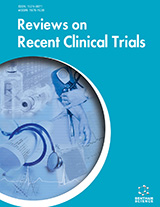Abstract
Background: The Ewing sarcoma (ES) represents 10 to 15% malignant bone tumors and 40 to 45% pediatric malignant bone tumors. The aim of this review is to clarify the therapeutic results and prognostic factors of this entity.
Methods: A systematic review of the literature was performed. Studies focused on the management of ES were considered for inclusion. Result: ES represents a model of multidisciplinary approach. The optimization of ES multimodality therapeutic strategies has resulted from the efforts of several national and international groups in Europe and North America and from cooperation between the pediatric and medical oncologists. The overall 5- year survival of Ewing localized tumors was 70% versus 30% in metastatic ES. Conclusion: The treatment of ES includes neoadjuvant and adjuvant chemotherapies with surgery and/or radiotherapy for control of the primary site and possible metastatic disease. The role of high-dose chemotherapy is still debated.Keywords: Chemotherapy, ewing sarcoma, malignant bone tumors, prognostic factor, therapeutic strategies, treatment.
Graphical Abstract
Reviews on Recent Clinical Trials
Title:A Review of Ewing Sarcoma Treatment: Is it Still a Subject of Debate?
Volume: 12 Issue: 1
Author(s): Wala Ben Kridis, Nabil Toumi, Hadil Chaari, Afef Khanfir, Kamel Ayadi, Hassib Keskes, Tahia Boudawara, Jamel Daoud and Mounir Frikha
Affiliation:
Keywords: Chemotherapy, ewing sarcoma, malignant bone tumors, prognostic factor, therapeutic strategies, treatment.
Abstract: Background: The Ewing sarcoma (ES) represents 10 to 15% malignant bone tumors and 40 to 45% pediatric malignant bone tumors. The aim of this review is to clarify the therapeutic results and prognostic factors of this entity.
Methods: A systematic review of the literature was performed. Studies focused on the management of ES were considered for inclusion. Result: ES represents a model of multidisciplinary approach. The optimization of ES multimodality therapeutic strategies has resulted from the efforts of several national and international groups in Europe and North America and from cooperation between the pediatric and medical oncologists. The overall 5- year survival of Ewing localized tumors was 70% versus 30% in metastatic ES. Conclusion: The treatment of ES includes neoadjuvant and adjuvant chemotherapies with surgery and/or radiotherapy for control of the primary site and possible metastatic disease. The role of high-dose chemotherapy is still debated.Export Options
About this article
Cite this article as:
Kridis Ben Wala, Toumi Nabil, Chaari Hadil, Khanfir Afef, Ayadi Kamel, Keskes Hassib, Boudawara Tahia, Daoud Jamel and Frikha Mounir, A Review of Ewing Sarcoma Treatment: Is it Still a Subject of Debate?, Reviews on Recent Clinical Trials 2017; 12 (1) . https://dx.doi.org/10.2174/1574887112666170120100147
| DOI https://dx.doi.org/10.2174/1574887112666170120100147 |
Print ISSN 1574-8871 |
| Publisher Name Bentham Science Publisher |
Online ISSN 1876-1038 |
 53
53 16
16
- Author Guidelines
- Bentham Author Support Services (BASS)
- Graphical Abstracts
- Fabricating and Stating False Information
- Research Misconduct
- Post Publication Discussions and Corrections
- Publishing Ethics and Rectitude
- Increase Visibility of Your Article
- Archiving Policies
- Peer Review Workflow
- Order Your Article Before Print
- Promote Your Article
- Manuscript Transfer Facility
- Editorial Policies
- Allegations from Whistleblowers
Related Articles
-
CT Findings of Pulmonary Metastases from Primary Cardiac Angiosarcoma
Current Medical Imaging Do HIV-Infected Immigrants Initiating HAART have Poorer Treatment-Related Outcomes than Autochthonous Patients in Spain? Results of the GESIDA 5808 Study
Current HIV Research Anticancer Drugs Discovery and Development from Marine Organisms
Current Topics in Medicinal Chemistry Iron Chelators in Cancer Chemotherapy
Current Topics in Medicinal Chemistry Histone Deacetylase Inhibitors in Cancer Therapy: New Compounds and Clinical Update of Benzamide-Type Agents
Current Topics in Medicinal Chemistry Of Man in Mouse: Modelling Human Cancer Genotype-Phenotype Correlations in Mice
Current Genomics Curcumin: Powerful Immunomodulator from Turmeric
Current Immunology Reviews (Discontinued) The Current View on the Helicase Activity of RNA Helicase A and Its Role in Gene Expression
Current Protein & Peptide Science The Synergistic Effects of DNA-Targeted Chemotherapeutics and Histone Deacetylase Inhibitors As Therapeutic Strategies for Cancer Treatment
Current Medicinal Chemistry Targeting Glioblastoma: The Current State of Different Therapeutic Approaches
Current Neuropharmacology Update on Hsp90 Inhibitors in Clinical Trial
Current Topics in Medicinal Chemistry Imaging of Abdominal Aortic Aneurysm: The Present and the Future
Current Vascular Pharmacology Hepatocellular Carcinoma Detection by Gallium Scan and Subsequent Treatment by Gallium Maltolate: Rationale and Case Study
Anti-Cancer Agents in Medicinal Chemistry Histone Deacetylase Inhibitors: From Chromatin Remodeling to Experimental Cancer Therapeutics
Current Medicinal Chemistry Antiidiotype-Derived Killer Peptides As New Potential Tools to Combat HIV-1 and AIDS-Related Opportunistic Pathogens
Anti-Infective Agents in Medicinal Chemistry Alternate Strategies of Hsp90 Modulation for the Treatment of Cancer and Other Diseases
Current Topics in Medicinal Chemistry Review on Triggered Liposomal Drug Delivery with a Focus on Ultrasound
Current Cancer Drug Targets “Bedside-to-Bench” Behavioral Outcomes in Animal Models of Pain: Beyond the Evaluation of Reflexes
Current Neuropharmacology Highly Active Antiretroviral Therapy and Cardiovascular Complications in HIV-Infected Patients
Current Pharmaceutical Design Regulatable Gene Expression Systems for Gene Therapy
Current Gene Therapy


























